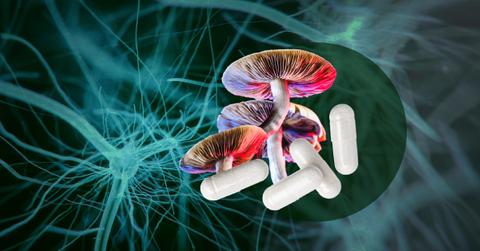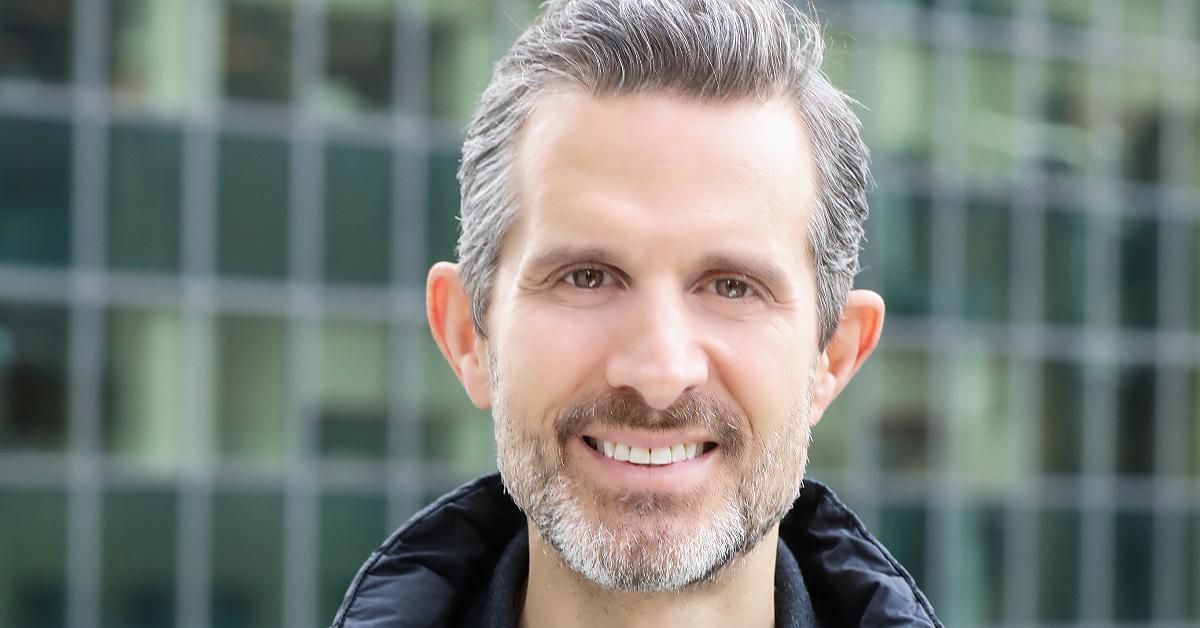From Ketamine to Magic Mushrooms, a Doctor Discusses the Magic of Psychedelic-Assisted Therapy (Exclusive)
Published Sept. 29 2023, 11:11 a.m. ET

The psychedelia movement of the '60s and '70s brings to mind creamsicle-hued swirls, long flowing hair, the Summer of Love, and groovy Beatles albums like Sgt. Pepper's Lonely Hearts Club Band and Magical Mystery Tour. Come on, do you really believe songs like "I Am The Walrus," "Strawberry Fields," and "Lucy in the Sky With Diamonds" were written by sober dudes? Those four mop-top musical geniuses were surely tripping on something in the late '60s. In fact, according to The Guardian, LSD (lysergic acid diethylamide, developed by Albert Hofmann in 1938) played a major role in the creation of the 1966 album Revolver.
But before psychedelic drugs inspired art, community, and a sense of peace in the 1960s, they were the subject of vast psychiatric research. During the 1950s, psychiatrist Humphry Osmond — who coined the label "psychedelic," or "mind manifesting" — found that hallucinogenic drugs like LSD had therapeutic potential, especially regarding treatment for alcoholism, per The Guardian. His groundbreaking studies were halted when LSD became associated with hippie counterculture and anti-war demonstrations, causing moral panic, as put by How to Change Your Mind author Michael Pollan.
According to the UC Berkeley Center for the Science of Psychedelics, many U.S. states prohibited psychedelic drugs as early as 1966. President Richard Nixon officially signed the Controlled Substances Act (CSA) in 1970, making drugs like LSD illegal.
Fast forward to present day, psychedelic drugs are still heavily stigmatized and in many cases illegal in the U.S. However, many doctors and researchers are working to change this, including Dr. Steven Radowitz, the chief medical officer and co-founder of New York City-based psychedelic wellness clinic Nushama.
With a mission to "humanize medicine" and "instigate a paradigm shift in the delivery of mental healthcare," Nushama (the name is based on the Hebrew word for soul, “Neshama") offers treatment, including off-label IV ketamine journeys for individuals with depression, anxiety, post-traumatic stress disorder (PTSD), alcohol use disorder (AUD), and more.

Dr. Steven Radowitz
According to the Drug Enforcement Administration (DEA), "ketamine is a dissociative anesthetic that has some hallucinogenic effects. It distorts perceptions of sight and sound and makes the user feel disconnected and not in control." Additionally, it can "induce a state of sedation (feeling calm and relaxed), immobility, relief from pain, and amnesia (no memory of events while under the influence of the drug)." Ketamine was first synthesized by scientist Calvin Stevens in 1962, per The Los Angeles Times.
Ketamine became a Schedule III non-narcotic substance under the CSA in 1999 and is legal in clinically-prescribed settings in the U.S. Recreational "Special K" is still illegal in the states. And though ketamine is approved by the U.S. Food and Drug Administration (FDA) as an anesthetic (on-label), as of this writing, IV ketamine infusion has not been approved by the FDA for treatment of psychiatric conditions (aside from treatment-resistant depression).
Along with two-plus decades of experience in internal medicine, Dr. Radowitz has done personal spiritual work with Kabbalah (esoteric Jewish mysticism) and transcendental meditation, a combination that has allowed him "to appreciate how our state of mind or consciousness impacts our physical health and well-being." Naturally, the Chicago Medical School grad found himself leading the psychedelic medicine movement.
In an exclusive e-interview, Green Matters spoke to Dr. Radowitz about the science behind ketamine-assisted therapy, psychedelic treatment as an answer to the mental health crisis, common misconceptions, and how psychedelics influence self-referential processing.
So, take a trip with us and learn about the healing, mystical, and stigmatized world of psychedelic-assisted therapy.
This interview has been edited and condensed for length and clarity.

Nushama
GREEN MATTERS: Your bio says that you believe "psychedelic medicine ... is the future of mental wellness, and current solutions often fall short, treating symptoms without addressing underlying issues." Can you expand on this?
DR. STEVEN RADOWITZ: Traditional psychiatric or psychopharmacologic approaches to treating mood disorders are generally symptom-based, seeing these disorders caused by imbalances in various neurotransmitter systems in the brain. Depression or anxiety are not disease entities. Instead, they are signals that something is out of alignment in a person’s life.
Psychedelics go to the root of the problem; instead of suppressing symptoms, people see their issues and traumas from a more objective standpoint. People have the opportunity to the source of what caused their ailments, process traumatic events, and grow from the experience, so these symptoms are no longer necessary.
GM: You lead the Ketamine for the Reduction of Alcohol Relapse (KARE) treatment program. Can you tell us about the science behind ketamine as a treatment?
SR: The human brain is responsible for our thoughts, emotions, and actions. It comprises countless interconnected neurons that communicate via synapses, with neurotransmitters playing a pivotal role in this process. Neurotransmitters locate receptors through random collisions, and a higher quantity of a neurotransmitter passing a receptor increases the likelihood of receptor activation.
Ketamine impacts a broad array of brain receptors, primarily influencing NMDA (N-methyl-D-aspartate) receptors — a subset of glutamate receptors situated in the limbic system responsible for learning, memory, and emotional regulation.
When glutamate activates NMDA receptors, it opens ion channels for positively charged ions to flow. Ketamine, however, obstructs these channels, preventing neuron excitation. As a result, certain neurotransmitters become inhibitory, opening channels for negatively charged ions and decreasing neuron spiking. This interference with neuron excitement paradoxically elevates neuronal activity.
Nushama’s KARE program for AUD integrates psychotherapy with ketamine-assisted sessions, proving significantly more effective and cost-efficient than traditional alcohol treatment programs. Psychedelics, due to their neurological effects, are gaining recognition for their innovative approaches to alcohol addiction treatment.
GM: How can other psychedelics be used in medicine?
SR: Ketamine and other classic psychedelics affect different brain regions, but they share the ability to quiet the Default Mode Network (DMN), which is associated with self-referential thinking and daydreaming. The DMN is essentially the brain's default state when not externally focused. Psychedelics promote neuroplasticity, which appears to reduce DMN activity. This reduction contributes to the temporary dissolution of the sense of self during ketamine therapy.
Ego dissolution is experienced through psychedelics, meditation, or spiritual practices. During this process, one may feel their identity shift and experience a sense of unity with the universe, interconnectedness, and profound insights, often linked to personal growth and self-discovery.
Following ego dissolution, individuals often report enduring changes in their perspectives, attitudes, and behaviors, attributed to neuroplasticity and then applied to daily life through therapy and integration.

Nushama
GM: Do you believe psychedelic treatment is the answer (or an answer) to the mental health crisis?
SR: I believe psychedelic therapy is one answer to the mental health crisis. Psychedelics are a tool for growth and there are many tools, including meditation, traditional psychiatric treatments, talk therapy, and medication when necessary.
We have done market research that revealed people are very interested in trying psychedelics for mental health. We conducted a national study on mental health, unveiling some surprising statistics. Drawing from a diverse sample of 1,300 Americans, this survey focuses on their attitudes toward mental health and the use of psychedelics as a potential solution.
Over a quarter of Americans describe their mental health as challenging. Only 20 percent of Americans are completely comfortable discussing their mental health, with the majority finding mental health topics to be either stigmatized, delicate, or in need of broader conversation. Psychedelic therapy promotes openness by delving into emotions and integrating experiences to address underlying issues. More than 33 percent of Americans use antidepressants and anti-anxiety medications.
A majority of Americans believe that psychiatry and psychopharmacology are not effectively addressing the current mental health crisis. Over a quarter of Americans express a willingness to explore psychedelic therapy for health benefits, and one in four Americans express interest in psychedelic-assisted therapy.
GM: What do you believe is the biggest misconception about psychedelic-assisted therapy?
SR: One common misunderstanding regarding psychedelic therapy is the belief in a “cure-all.” It's essential to recognize that psychedelic-assisted therapy is not a magical solution. Instead, it serves as a tool to open doors and reveal possibilities. The real transformative work lies in the hands of the individual through integration efforts for long-lasting change.
While a significant percentage of our members, about 70 to 80 percent, experience noticeable improvements, we attribute only 10 percent of this progress to the ketamine molecule itself and another 10 percent to the initial diagnosis. The remaining 80 percent of the work involves preparation and integration.
At Nushama, every therapy session includes the guidance of integrators who help members set preparation intentions and extract valuable insights from their experiences. Sustaining the mental health benefits requires the incorporation of these insights into one's daily life.
To support this ongoing process, we offer year-round programs such as breathwork and sound therapy. We also encourage daily practices like meditation, journaling, spiritual wisdom, and expressing gratitude.
GM: Currently, what is the biggest unknown about the short- and long-term effects of psychedelic-assisted therapy?
SR: Psychedelic therapy is more than just the molecule being used, from ketamine or psilocybin to MDMA. There are other factors, like set and setting, which can affect both short-term and long-term integration.
How to optimize other modalities with therapy, music, and various aspects of the psychedelic experience is also unknown. We don’t know how much of these factors influence people’s responses. Additionally, what other diagnoses may benefit from psychedelic medicines? We are still studying how various psychedelics could possibly help those with other neurological ailments.